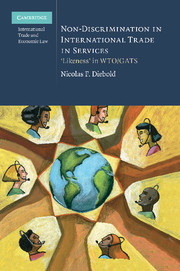Book contents
- Frontmatter
- Contents
- Foreword
- Acknowledgements
- Abbreviations
- List of Cases
- List of Legal Texts
- List of Documents
- Introduction
- PART I Foundations
- 1 Objective and forms of non-discrimination
- 2 Particularities of trade in services and GATS
- 3 Legal elements of non-discrimination obligations
- 4 Concluding summary: reconciling the three elements
- PART II Framing the conceptual breadth of ‘likeness’ in GATS
- PART III GATS specific ‘likeness’ issues
- PART IV Methodology for the ‘likeness’ analysis in GATS
- Bibliography
- Index
2 - Particularities of trade in services and GATS
Published online by Cambridge University Press: 10 January 2011
- Frontmatter
- Contents
- Foreword
- Acknowledgements
- Abbreviations
- List of Cases
- List of Legal Texts
- List of Documents
- Introduction
- PART I Foundations
- 1 Objective and forms of non-discrimination
- 2 Particularities of trade in services and GATS
- 3 Legal elements of non-discrimination obligations
- 4 Concluding summary: reconciling the three elements
- PART II Framing the conceptual breadth of ‘likeness’ in GATS
- PART III GATS specific ‘likeness’ issues
- PART IV Methodology for the ‘likeness’ analysis in GATS
- Bibliography
- Index
Summary
Even though international trade in services has been part of the multilateral trading system for over ten years, many uncertainties remain in the application of its trade rules. While the underlying economic theories as well as the legal instruments for liberalizing international trade in services are largely the same as for the liberalization of trade in goods, numerous inherent differences between trade in services and trade in goods render the process of liberalization and the implementation of trade rules for services more difficult. Thus, before venturing into the specific elements of non-discrimination and the concept of ‘likeness’, it is indispensable to present a brief overview of the main particularities of international trade in services in the GATS framework in general (below, I.) and of the main GATS obligations in particular (II.). It must be emphasized, however, that chapter 2 is limited to provide the basic information needed by the reader unfamiliar with GATS to understand this study on GATS non-discrimination rules and ‘likeness’.
Modes and methods of service supply in GATS
A first and important difference between goods and services is that the latter are extremely heterogeneous and hence quasi impossible to conceptualize both in terms of substance and in terms of characteristics. From a substantive perspective, the Secretariat's revised Services Sectoral Classification List groups all services under the following 12 different sectors, which are divided into some 160 sub-sectors.
- Type
- Chapter
- Information
- Non-Discrimination in International Trade in Services‘Likeness' in WTO/GATS, pp. 23 - 31Publisher: Cambridge University PressPrint publication year: 2010
- 1
- Cited by



